Srinagar, Oct 25:
Despite a significant shortfall of around 500 MW in power supply across Jammu and Kashmir, fulfilling newly elected Chief Minister Omar Abdullah’s promise of providing 200 units of free electricity to every household appears to be a daunting task. Although the new administrative structure allows for this initiative, with Lieutenant Governor Manoj Sinha overseeing the region’s budget, the public is hopeful for relief from the burden of electricity tariffs.
As per PDD website, currently the corporation operates 21 hydroelectric projects with a combined capacity of 758.70 MW, including the 450 MW Baglihar Hydroelectric Project. The corporation also manages gas turbines with a capacity of 175 MW located in Pampore, near Srinagar. In line with the State Hydel Policy of 2003, JKSPDC has allocated 10 small hydroelectric projects under the Independent Power Producer (IPP) phase-I, which collectively have a capacity of 110.50 MW.
Despite these resources, the total electricity supply falls significantly short of the current demand, which stands at approximately 2,600 MW. The Kashmir division receives only about 1,200 MW, while Jammu is supplied with 900 MW.
Officials from the Kashmir Power Development Corporation Limited (KPDCL) report that electricity demand has surged in the Kashmir Valley due to colder weather, resulting in a substantial power deficit as winter approaches.
Residents are feeling the strain. Firdousa Akthar, a widow from the Dandarkha slum in Magarmal Bagh, expressed her struggles, saying, “I only use two bulbs and a cooking heater, yet my monthly electricity bill still comes to Rs 2,000.” Akthar struggles to pay the tariff online due to her lack of education, which further adds to her difficulties.
Mohammad Latif Khan, of Khanyar in Srinagar, said, “My father, who is in his 70s, suffers from COPD. We had to invest in a generator to ensure his oxygen concentrator operates without interruptions. Unfortunately, not all families can afford a generator. Prolonged power outages can be life-threatening for patients like him.”
“What’s the purpose of installing smart meters if they can’t ensure reliable electricity?” asked Muzaffar Ahmad, a resident of Jawahar Nagar. “We’re only getting 9 hours of power, which is insufficient for our daily needs.”
The PDD officials noted that the current electricity load requirement for Kashmir is a remarkable 1,400 MW for 6 hours daily and 1,000 MW for the remaining 18 hours.
Even the regions designated by the KPDCL for uninterrupted power supply have been affected by outages. More than 40 feeders in these areas are experiencing daily power cuts of 5 to 6 hours, leading to significant difficulties for residents and businesses alike.
It’s worth noting that the power sector in Jammu and Kashmir is still grappling with significant challenges, with its Aggregate Technical and Commercial (AT&C) losses ranking among the highest in India. Recent data shows that these losses have improved, declining from 63% in 2021-22 to 44% in 2023-24. However, this remains alarmingly above the national average of about 15%.
“The J&K Power Department is experiencing one of the highest AT&C losses in the country, currently at 44%, compared to the national average of 15.9%. This substantial loss creates a significant gap between the expenses related to power purchases and the revenue generated,” an official said.
AT&C losses consist of technical losses due to limitations in infrastructure as well as commercial losses resulting from issues like billing mistakes, theft, and unpaid bills. The high rate of losses in Jammu and Kashmir is linked to several factors, including the region’s challenging geography.
“The extensive low-tension (LT) lines that deliver electricity to far-flung and isolated homes in the mountainous regions lead to considerable I2R losses, which significantly increase the cost of power supply in Jammu and Kashmir.”
Meanwhile, in a significant development, the Ministry of New & Renewable Energy (MN&RE) has disbursed a central subsidy of Rs 48.73 lakh to 57 domestic consumers under the PM Surya Ghar: Muft Bijli Yojana in the Kashmir Division. This funding was allocated just one week after the commissioning of their rooftop solar plants by KPDCL’s technical teams.
The central subsidy for an additional 71 beneficiaries has already been approved by MN&RE and will be directly deposited into their accounts via DBT mode.
In a press statement issued today, a KPDCL spokesman said that beneficiaries of the central subsidy under the PM Surya Ghar Yojana are also eligible for an additional UT subsidy of Rs 9,000 for solar plants with a capacity of up to 3 KWP, which will be released soon.
The KPDCL spokesman emphasized that subsidies for consumers are issued in real-time for those whose documentation is fully complete on the National PM Surya Ghar Portal.
“Domestic consumers in the Kashmir Division are urged to take full advantage of the heavily subsidized scheme, which provides up to 60% support,” the spokesperson said. “Currently, 1,105 consumers have selected their approved vendors and are at different stages of procuring solar plant equipment. To date, 169 rooftops have been installed, totalling 671.37 kW, with an average capacity of 4 KWP per installation.”
KPDCL is anticipating the next release of a Central subsidy totalling Rs. 61.77 lahks for 72 beneficiaries whose claims have already been approved.
The spokesperson expressed confidence that with 1,105 vendors already selected by consumers, the installed capacity is expected to reach 3.5 MW over the next two months, significantly easing the demand on grid supply.








